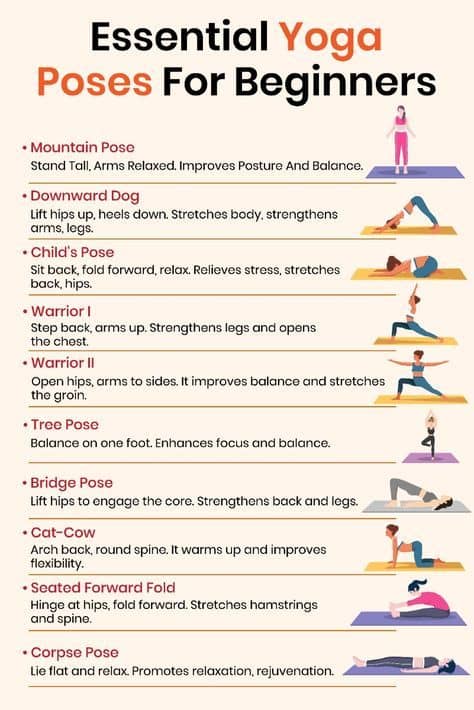10 Essential Yoga Poses for Beginners: A Comprehensive Guide to Start Your Journey
Are you looking to kickstart a healthier lifestyle, improve your flexibility, and enhance your sense of overall well-being? Look no further than yoga. Yoga, an ancient practice with roots in India, combines physical postures (asanas), breathing techniques (pranayama), and mindfulness to create a holistic experience for mind and body. Whether you are aiming to relieve stress, increase strength, or simply find a new way to stay active, incorporating yoga into your routine can be a rewarding journey.
In this comprehensive guide, we will explore 10 essential yoga poses for beginners that will help you set a strong foundation. From improving posture and balance to calming the mind, these poses address various aspects of wellness and are designed to be accessible to virtually anyone. Read on to learn more about each pose, its benefits, and tips to safely practice them—even if you’re just starting out.
Table of Contents
- The Benefits of Yoga for Beginners
- Important Considerations Before You Begin
- Pose 1: Mountain Pose (Tadasana)
- Pose 2: Downward-Facing Dog (Adho Mukha Svanasana)
- Pose 3: Child’s Pose (Balasana)
- Pose 4: Warrior I (Virabhadrasana I)
- Pose 5: Warrior II (Virabhadrasana II)
- Pose 6: Tree Pose (Vrksasana)
- Pose 7: Bridge Pose (Setu Bandha Sarvangasana)
- Pose 8: Cat-Cow (Marjaryasana-Bitilasana)
- Pose 9: Seated Forward Fold (Paschimottanasana)
- Pose 10: Corpse Pose (Savasana)
- Tips for a Safe and Beneficial Practice
- Conclusion
1. The Benefits of Yoga for Beginners
Yoga is not just about bending and stretching—it is a holistic practice that nourishes the body and mind. Some of the top benefits include:
- Stress Relief: Focused breathing and mindful movement calm the nervous system, reducing cortisol levels and helping you manage stress more effectively.
- Improved Flexibility: Regular practice gradually increases range of motion in muscles and joints.
- Strength Building: Holding poses uses body weight as resistance, helping develop toned muscles.
- Better Balance and Posture: Engaging core muscles and practicing alignment in poses can improve posture and overall stability.
- Enhanced Energy Levels: Controlled breathing and movement boost blood circulation, promoting higher energy and vitality.
- Mindfulness and Mental Clarity: Yoga encourages you to stay present, reducing mental chatter and cultivating a more peaceful mindset.
2. Important Considerations Before You Begin
Before diving into the poses, here are a few points to keep in mind:
- Consult a Professional: If you have any chronic injuries, medical conditions, or concerns, consult a healthcare professional or certified yoga instructor before starting a practice.
- Pick the Right Environment: Choose a calm, open space with enough room to stretch out. A yoga mat provides comfort and traction.
- Listen to Your Body: Only move within your comfort zone. If you experience pain or intense discomfort, back off and modify the pose.
- Stay Hydrated: Drink water before and after your session to keep your body hydrated.
- Practice Regularly: Consistency is key. Short, frequent sessions often bring more benefits than occasional long practices.
- Use Props if Needed: Yoga blocks, straps, blankets, or cushions can help make the poses more accessible and comfortable.
3. Pose 1: Mountain Pose (Tadasana)
Description
Often considered the foundation for all standing poses, Mountain Pose (Tadasana) emphasizes proper alignment and a strong posture. It might look simple—standing upright—but it sets the stage for more complex poses by training your body to maintain the correct posture and weight distribution.
How to Do It
- Stand on your mat with feet together or hip-width apart, whichever is more comfortable.
- Keep your arms by your sides with palms facing forward or relaxed at your thighs.
- Engage your leg muscles, slightly tuck your tailbone, and lift your chest.
- Imagine a string pulling the crown of your head towards the ceiling, elongating your spine.
- Relax your shoulders away from your ears and breathe deeply.
Benefits
- Improves posture and balance
- Strengthens the legs and core
- Grounds and centers the mind
Beginner Tips
- If you feel wobbly, keep your feet a little wider apart.
- Practice in front of a mirror to ensure your spine is long and straight, with shoulders level.
4. Pose 2: Downward-Facing Dog (Adho Mukha Svanasana)
Description
Downward-Facing Dog is one of the most iconic yoga poses. It’s often part of a flow sequence in many styles of yoga, thanks to its ability to stretch and strengthen multiple areas of the body simultaneously.
How to Do It
- Start on all fours with your wrists underneath your shoulders and knees beneath your hips.
- Spread your fingers wide and press into the mat, activating your arms.
- On an exhale, lift your knees away from the floor and extend your hips up and back.
- Keep your knees slightly bent at first, especially if your hamstrings feel tight.
- Press your heels toward the ground while lengthening your spine.
- Relax your head and neck, letting them hang naturally between your arms.
Benefits
- Strengthens arms, shoulders, and legs
- Stretches hamstrings and calves
- Helps relieve back tension by lengthening the spine
Beginner Tips
- It’s okay if your heels don’t touch the ground—focus on a straight spine rather than forcing your heels down.
- Engage your core to avoid straining the lower back.
5. Pose 3: Child’s Pose (Balasana)
Description
Child’s Pose is a gentle resting pose often used between more strenuous postures. It helps you reconnect with your breath, stretch the lower back, and calm the mind.
How to Do It
- Kneel on the mat with your knees about hip-width apart.
- Sit your hips back onto your heels.
- Fold forward, resting your torso between or on top of your thighs.
- Extend your arms forward, palms facing down, or let them rest alongside your body.
- Lower your forehead to the mat and breathe deeply.
Benefits
- Stretches the back, hips, and ankles
- Relieves stress and tension
- Encourages relaxation and introspection
Beginner Tips
- If your forehead doesn’t reach the mat comfortably, place a folded blanket or pillow under your head.
- Keep your knees closer or wider, depending on comfort.
6. Pose 4: Warrior I (Virabhadrasana I)
Description
A strong standing posture, Warrior I builds lower body strength, opens the hips, and helps improve balance. It also stretches the chest, promoting better posture and breathing.
How to Do It
- Start in Mountain Pose. Step one foot back about 3 to 4 feet, turning your back foot out slightly (around 45 degrees).
- Bend the front knee so that it’s directly above the ankle.
- Square your hips toward the front of the mat.
- Inhale as you lift your arms overhead, palms facing each other or touching.
- Keep the torso upright and focus on lengthening through the spine.
Benefits
- Strengthens the thighs, calves, and ankles
- Opens the chest and lungs
- Engages the core for stability
Beginner Tips
- If balancing is difficult, widen your stance slightly by moving the feet hip-width apart.
- Ensure your knee doesn’t collapse inward; keep it aligned with your second toe.
7. Pose 5: Warrior II (Virabhadrasana II)
Description
Another powerful standing pose, Warrior II helps improve balance and posture. The extended arms and wide stance work the legs and open the groin area. This pose fosters a sense of stability and focus.
How to Do It
- Begin with your feet about 3 to 4 feet apart.
- Turn your right foot out 90 degrees and your left foot in slightly (about 15 degrees).
- Align your heels or keep a comfortable stance that maintains hip alignment.
- Bend your right knee so it’s over the ankle, forming a right angle.
- Lift your arms parallel to the floor, palms facing down.
- Gaze over your right fingertips, keeping your shoulders down and relaxed.
Benefits
- Strengthens and stretches the legs and ankles
- Improves balance and stability
- Opens the chest and stretches the shoulders
Beginner Tips
- If your hips feel tight, reduce the distance between your feet.
- Keep your gaze steady to aid concentration.
8. Pose 6: Tree Pose (Vrksasana)
Description
Tree Pose focuses on improving balance, concentration, and core strength. It is a simpler balancing posture, making it an excellent choice for beginners working on stability and leg strength.
How to Do It
- Start from Mountain Pose with feet together or hip-width apart.
- Shift your weight onto your right foot.
- Lift your left foot and place it on the inside of your right calf or inner thigh (avoid the knee joint).
- Press your foot into your leg and your leg into your foot for stability.
- Bring your hands to your heart center in a prayer position or stretch them overhead.
- Look at a fixed point in front of you to help maintain balance.
Benefits
- Strengthens ankles, calves, and thighs
- Improves balance and focus
- Helps develop core stability
Beginner Tips
- Hold onto a wall or chair if you feel unsteady.
- Start by placing your foot lower on your standing leg (like on the ankle) until you gain more confidence.
9. Pose 7: Bridge Pose (Setu Bandha Sarvangasana)
Description
Bridge Pose is a backbend that strengthens the core, legs, and back while opening the chest. It can help reverse the effects of prolonged sitting by stretching the front of the body.
How to Do It
- Lie on your back with your knees bent and feet flat on the ground, hip-width apart.
- Rest your arms alongside your body, palms down.
- On an inhale, press your feet and arms into the mat and lift your hips toward the ceiling.
- Clasp your hands under your back and press your arms into the mat for additional support, or keep palms down if clasping is uncomfortable.
- Keep your thighs parallel and chest lifted.
- Exhale as you gently lower your hips back to the mat.
Benefits
- Strengthens the back, glutes, and hamstrings
- Opens the chest and shoulders
- Stimulates the abdominal organs and thyroid gland
Beginner Tips
- Place a yoga block or cushion under your sacrum for a supported bridge variation.
- Keep your neck in a neutral position; avoid looking side-to-side to protect your cervical spine.
10. Pose 8: Cat-Cow (Marjaryasana-Bitilasana)
Description
Actually two poses seamlessly combined, Cat-Cow provides a gentle flow that warms up the spine and core. It is especially helpful for increasing back flexibility and encouraging healthy spinal alignment.
How to Do It
- Begin on all fours with hands under shoulders and knees under hips.
- For Cow Pose (Bitilasana), inhale as you arch your back, lowering your belly toward the mat, and lift your head and chest.
- For Cat Pose (Marjaryasana), exhale as you round your spine, tucking your chin toward your chest and drawing your belly button toward your spine.
- Alternate between these two shapes with each inhale and exhale, moving smoothly.
Benefits
- Warms and stretches the spine
- Mobilizes the neck and shoulders
- Encourages synchronization of breath and movement
Beginner Tips
- Keep your movements slow and controlled. Focus on the sensation of each vertebra moving.
- Ensure your shoulders and hips stay aligned; avoid shifting your weight too far forward or back.
11. Pose 9: Seated Forward Fold (Paschimottanasana)
Description
Seated Forward Fold stretches the entire backside of the body, from the calves and hamstrings to the spine. It’s a calming posture that also helps improve digestion and reduce stress.
How to Do It
- Sit on your mat with legs extended in front of you.
- Flex your feet to engage the legs.
- Inhale to lengthen your spine, and as you exhale, fold forward from the hips.
- Keep your spine as straight as possible and reach for your shins, ankles, or feet—wherever you can comfortably hold without rounding your back excessively.
- Breathe deeply, focusing on extending the spine on each inhale and folding deeper on each exhale.
Benefits
- Stretches hamstrings, calves, and lower back
- Helps alleviate stress and anxiety
- Can improve posture and spine mobility
Beginner Tips
- Use a strap around your feet if you can’t comfortably reach them.
- Sit on a folded blanket or cushion to lift your hips and reduce tension in the lower back.
12. Pose 10: Corpse Pose (Savasana)
Description
Corpse Pose is the ultimate relaxation posture and is typically performed at the end of a yoga session. It allows your body and mind to fully absorb the benefits of your practice while promoting deep rest and rejuvenation.
How to Do It
- Lie on your back with your legs extended and arms by your sides.
- Let your feet fall open naturally, and rest your palms facing upward.
- Close your eyes and breathe naturally.
- Allow every muscle in your body to relax, from your forehead to your toes.
- Stay in this pose for at least five minutes, or longer if time permits.
Benefits
- Promotes relaxation and reduces stress
- Calms the mind
- Allows the body to integrate the physical and mental benefits of your practice
Beginner Tips
- If lying flat on your back is uncomfortable, place a bolster or pillow under your knees.
- Use a blanket for warmth if the room is cool.
13. Tips for a Safe and Beneficial Practice
- Warm Up Properly
Begin each session with gentle movements like neck rolls, shoulder rolls, or hip rotations to prepare your body for deeper stretches. - Maintain Steady Breathing
Inhale and exhale through the nose if possible. This helps regulate airflow and maintain focus. - Focus on Alignment
Proper alignment helps prevent injuries and ensures you get the most out of each posture. - Avoid Overstretching
Find a comfortable edge—never push to the point of sharp pain. Yoga is a gradual process of building flexibility. - Stay Mindful
Keep your awareness on the present moment, the physical sensations, and your breath. This mindfulness is where the calming power of yoga truly resides. - Cool Down
End with relaxing poses like Seated Forward Fold or Supine Twists to bring your heart rate and breathing back to normal. Finish with Corpse Pose for deep relaxation. - Seek Guidance
If you’re uncertain about any pose, consider taking a few classes with a certified yoga instructor. This ensures correct form and reduces risk of injuries.
14. Conclusion
Starting a yoga practice can seem overwhelming, but focusing on these 10 essential yoga poses for beginners will give you a strong and safe foundation. Over time, you may notice improvements in flexibility, strength, and mental clarity. From the grounding energy of Mountain Pose to the soothing relaxation of Corpse Pose, each posture in your beginner’s toolbox serves a unique purpose for both body and mind.
Remember that yoga is not a competition—it’s a personal journey of growth, self-awareness, and wellness. With regular practice, patience, and a mindful approach, you’ll soon discover the transformative effects yoga can bring into your life.
Ready to get started? Roll out your mat, pick a pose, and begin your path to better health, balance, and inner peace. And if you ever feel stuck or need a refresher, come back to these foundational poses to refine your form and reconnect with the fundamentals. Your yoga journey awaits—namaste!
Disclaimer: This article is for informational purposes only and not a substitute for professional medical advice, diagnosis, or treatment. Always consult your physician or qualified health provider with any questions you may have regarding a medical condition or starting a new exercise program.










